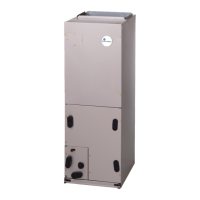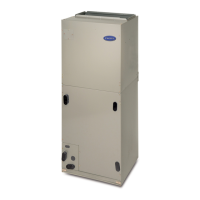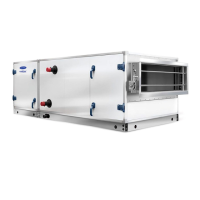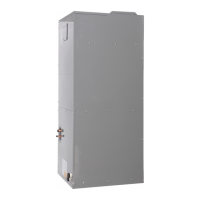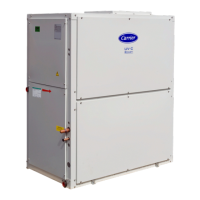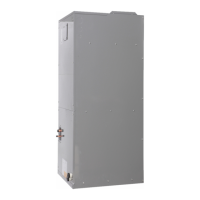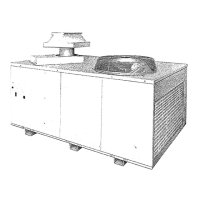103
VFD2 Nominal Motor HPwr (N.PWR)
This configuration defines the nominal motor power. This value
must equal the value of the combined HP of both motors. Motor
HP is found on the motor rating plate. Power to the VFD must be
cycled in order for a change to this configuration to take effect.
VFD2 Motor Direction (M.DIR)
This configuration sets the direction of motor rotation. Motor di-
rection change occurs immediately upon a change to this configu-
ration. Power to the VFD need NOT be cycled for a change to this
configuration to take effect.
VFD2 Acceleration Time (ACCL)
This configuration sets the acceleration time from zero to maxi-
mum output frequency. Power to the VFD must be cycled in order
for a change to this configuration to take effect.
VFD2 Deceleration Time (DECL)
This configuration sets the deceleration time from maximum out-
put frequency to zero. Power to the VFD must be cycled in order
for a change to this configuration to take effect.
VFD2 Switching Frequency (SW.FQ)
This configuration sets the switching frequency for the drive.
Power to the VFD must be cycled in order for a change to this
configuration to take effect.
VFD2 Type (TYPE)
This configuration sets the type of VFD communication. This
configuration should not be changed without first consulting a
Carrier service engineering representative.
Remote Control Switch Input
The remote switch input is located on the RXB board and connect-
ed to TB201 terminals 3 and 4. The switch can be used for several
remote control functions. See Table 83.
Table 83 — Remote Switch Configuration
Remote Input State (Inputs
GEN.I
REMT)
This is the actual real time state of the remote input.
Remote Switch Config (Configuration
UNIT
RM.CF)
This is the configuration that allows the user to assign different
types of functionality to the remote discrete input.
• 0 — NO REMOTE SW — Remote switch will not be used.
• 1 — OCC-UNOCC SW — The remote switch input will con-
trol the occupancy state. When the remote switch input is ON,
the unit is forced into the occupied mode. When the remote
switch is OFF, the unit is forced into the unoccupied mode.
• 2 — STRT/STOP — The remote switch input will start
and stop the unit. When the unit is commanded to stop, any
timeguards in place on compressors will be honored first.
When the remote switch is ON, the unit will be command-
ed to stop. When the remote switch is OFF, the unit will be
enabled to operate.
• 3 — OVERRIDE SW — The remote switch can be used to
override any internal or external time schedule being used
by the control and force the unit into an occupied mode
when the remote input state is ON. When the remote
switch is ON, the unit will be forced into an occupied state.
When the remote switch is OFF, the unit will use its inter-
nal or external time schedules.
Remote Switch Logic Configuration (Configuration
SW.LG
RMI.L)
The control allows for configuration of a normally open/closed
status of the remote input switch via RMI.L. If this variable is
configured OPEN, then when the switch is open, the remote in-
put switch perceives the logic state as OFF. Correspondingly, if
RMI.L is set to CLOSED, the remote input switch will perceive
a closed switch as meaning OFF. See Table 84.
Table 84 — Remote Switch Logic Configuration
ITEM EXPANSION RANGE UNITS CCN POINT
REMT Remote Input State ON/OFF RMTIN
RM.CF Remote Switch Config 0 to 3 RMTINCFG
RMI.L RemSw Off-Unoc-Strt-NoOv Open/Close RMTINLOG
REMOTE
SWITCH LOGIC
CONFIGURATION
(RMI.L)
SWITCH
STATUS
REMOTE INPUT STATE
(REMT)
REMOTE SWITCH CONFIGURATION (RM.CF)
0123
No Remote Switch Occ-Unocc Switch Start/Stop Override
OPEN
OPEN OFF (0) xxxxx Unoccupied Start No Override
CLOSED ON (1) xxxxx Occupied Stop Override
CLOSED
OPEN ON (0) xxxxx Occupied Stop Override
CLOSED OFF (1) xxxxx Unoccupied Start No Override

